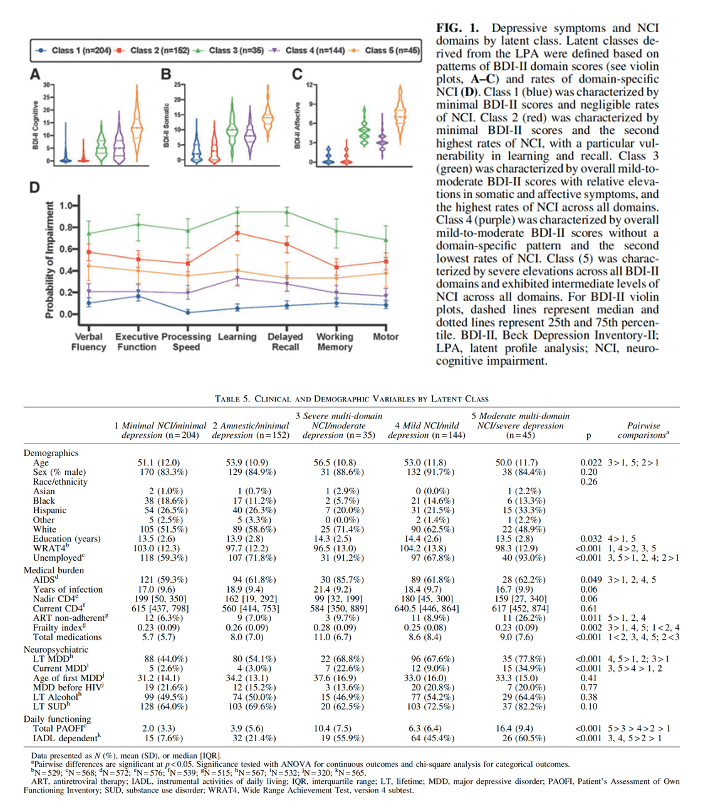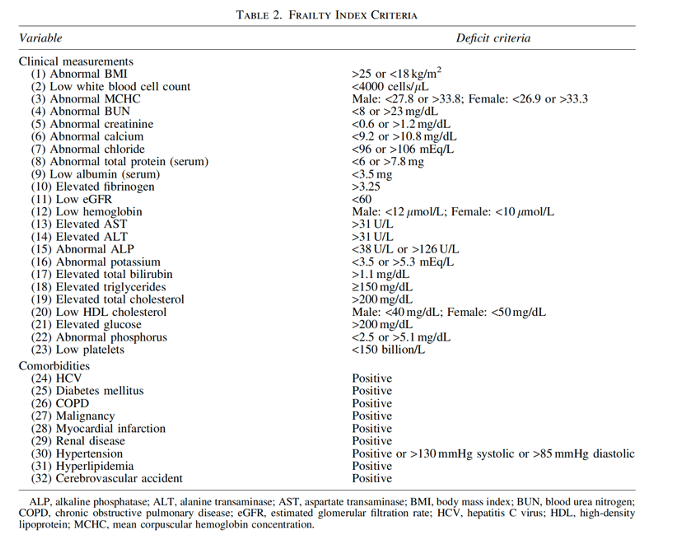| |
Latent Profile Analysis of Cognitive Performance
and Depressive Symptoms Among People with HIV
|
| |
| |
Download the PDF here
Maulika Kohli, MS,1,2 Lillian Ham, MS,1,2 Rowan Saloner, PhD,3 Devin Dung, BS,2 Jennifer Iudicello, PhD,2,4 Ronald J. Ellis, MD, PhD,2,4,5 and David J. Moore, PhD 2,4
Published Online:15 Feb 2024
DISCUSSION: Our study successfully identified five distinct classes of PWH on suppressive ART, varying on the basis of NCI and depression symptomatology. These classes ranged from those exhibiting minimal NCI and depression to those experiencing severe multi-domain NCI coupled with significant depressive symptoms. Clinical and demographic correlates of these classes suggested that those with moderate-to-severe NCI and depressive symptoms tended to be older, report nonadherence to ART, carry a higher burden of comorbidity, and display more significant everyday functional impairment.
With respect to NCI, 41.6% of participants met criteria for global NCI and rates of domain-specific NCI ranged from 38.6% (learning) to 25.0% (processing speed). With respect to depression, 56.6% met criteria for lifetime MDD, 8.1% met criteria for current MDD, and the median BDI-II score in the total cohort was 8 (interquartile range = 3-16). Of those with a lifetime MDD diagnosis, 19.1% had their first depressive episode before their estimated acquisition of HIV. Approximately 69.2% of participants identified as unemployed.
A stair-step pattern was observed for self-reported neurocognitive symptoms (total PAOFI scores; Fig. 2C) such that Class 5 reported the highest number of neurocognitive symptoms, followed by Class 3, then Class 4, then Class 2, and then Class 1. Rates of unemployment were significantly higher in Class 5 (93%) and 3 (91%) relative to other classes. Similarly, rates of IADL dependence were highest in Class 5 (61%), 3 (56%), and 4 (45%), followed by Class 2 (21%) and then Class 1 (8%).
The average estimated duration of HIV disease was 18 years and most participants exhibited evidence of ART-induced immune reconstitution, indicated by higher current CD4 counts (median = 596 cells/mm3) compared to nadir CD4 counts (median = 175 cells/mm3).
Abstract
Depression and cognitive impairment are prevalent conditions among people with HIV (PWH), likely attributable to shared causes and common risk factors. Identifying subtypes of PWH with similar patterns of neurocognitive impairment (NCI) and depressive symptoms may inform development of patient-centered interventions that target-specific profiles.
This study aimed to (1) classify PWH based on patterns of domain-specific NCI and depression; and (2) determine the relationship between latent class membership and pertinent clinical characteristics.
PWH (N = 580, 86.2% male, 57.1% non-Hispanic White, 69.2% unemployed) completed a comprehensive neuropsychological test battery assessing global and domain-specific cognition.
Domain-specific NCI was classified as deficit score >0.5. Participants completed the Beck Depression Inventory-II (BDI-II), and domain-specific BDI-II scores reflecting cognitive, affective, and somatic symptoms were computed.
Latent profile analysis (LPA) was used to determine latent subgroups of NCI and depression.
The optimal LPA solution consisted of five classes: minimal NCI and minimal depression (Class 1), amnestic and minimal depression (Class 2), severe multi-domain NCI and moderate depression (somatic and affective; Class 3), mild NCI and mild depression (Class 4), and moderate multi-domain NCI and severe depression (Class 5).
Despite similar levels of functional impairment, Class 5 had a significant psychiatric profile, whereas Class 3 had a complex medical profile (i.e., higher frailty index, higher medications, greater proportion of AIDS diagnosis). In contrast, Class 1 had the lowest medication use and frailty index, with similar HIV disease characteristics to Classes 3 and 5.
Our results suggest there are multiple pathways to cognitive and functional impairment among PWH with co-occurring depression and cognitive impairment, and these groups may respond differently to interventions. Of note, our sample was majority non-Hispanic White and male, which is nonrepresentative of the US population of PWH. Future interventions should consider a more integrated, person-centered approach that addresses cognitive and emotional health to optimize health outcomes in PWH.


|
|
| |
| |
|
|
|